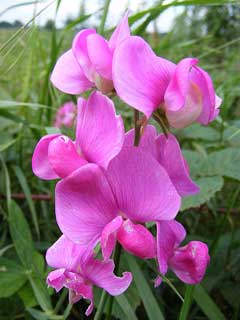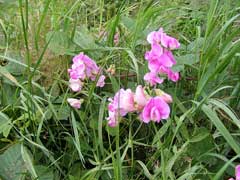 |
|
http://commons.wikimedia.org/wiki/User:TeunSpaans |
 |
| http://commons.wikimedia.org/wiki/User:TeunSpaans |
Translate this page:
Summary
Bloom Color: Pink, Red, White.
Main Bloom Time: Early summer, Late summer, Mid summer. Form: Spreading or horizontal.
Physical Characteristics

 lathyrus latifolius is a PERENNIAL CLIMBER growing to 2 m (6ft) by 2 m (6ft) at a fast rate.
lathyrus latifolius is a PERENNIAL CLIMBER growing to 2 m (6ft) by 2 m (6ft) at a fast rate.
See above for USDA hardiness. It is hardy to UK zone 5 and is not frost tender. It is in flower from July to September, and the seeds ripen from August to October. The species is hermaphrodite (has both male and female organs) and is pollinated by Bees.
It can fix Nitrogen.
Suitable for: light (sandy), medium (loamy) and heavy (clay) soils. Suitable pH: mildly acid, neutral and basic (mildly alkaline) soils. It can grow in semi-shade (light woodland) or no shade. It prefers dry or moist soil and can tolerate drought.
UK Hardiness Map
US Hardiness Map
Synonyms
Plant Habitats
Woodland Garden Sunny Edge; Dappled Shade; Shady Edge; Ground Cover; Meadow;
Edible Uses
Edible Parts: Leaves Seed Seedpod
Edible Uses:
Seed - cooked[105, 177]. Some caution is advised, see the notes above on toxicity. Young seedpod - cooked[105, 177]. Young plant - cooked[105, 177]. Hank Shaw, author of Hunt, Gather, Cook: Finding the Forgotten Feast, notes that there is no documented evidence of humans being poisoned by wild peas. He concludes that eating small amounts of wild peas is generally safe, unless someone has an unpredictable allergy to them.
References More on Edible Uses
Medicinal Uses
Plants For A Future can not take any responsibility for any adverse effects from the use of plants. Always seek advice from a professional before using a plant medicinally.
None known
References More on Medicinal Uses
The Bookshop: Edible Plant Books
Our Latest books on Perennial Plants For Food Forests and Permaculture Gardens in paperback or digital formats.

Edible Tropical Plants
Food Forest Plants for Hotter Conditions: 250+ Plants For Tropical Food Forests & Permaculture Gardens.
More

Edible Temperate Plants
Plants for Your Food Forest: 500 Plants for Temperate Food Forests & Permaculture Gardens.
More

More Books
PFAF have eight books available in paperback and digital formats. Browse the shop for more information.
Shop Now
Other Uses
Plants can be grown without supports when they will sprawl on the ground and can be used as a ground cover plant in a sunny position[188, 202]. They should be spaced about 1.5 metres apart each way[208]. They are very vigorous and so are best not used with small plants[K]. They also die down completely in the winter, giving weeds a chance to become established[K].
Special Uses
Food Forest Ground cover Nitrogen Fixer
References More on Other Uses
Cultivation details
Landscape Uses:Arbor, Container. An easily grown plant, succeeding in any moderately good garden soil[200], whether acid or alkaline[202]. Prefers a position in full sun but tolerates part day shade[200]. Succeeds in dry soils and is drought tolerant when established[190]. Grows well on dry slopes[208]. Plants can be grown in quite coarse grass, which can be cut annually in the autumn[233]. Plants are hardy to at least -10°c[202]. A very ornamental plant[1], there are many named varieties[187]. It is fast-growing and, when in a suitable position, can become invasive[202]. Plants climb by means of tendrils[188]. Resents root disturbance and can take a year or two to settle down after being moved[219]. This species has a symbiotic relationship with certain soil bacteria, these bacteria form nodules on the roots and fix atmospheric nitrogen. Some of this nitrogen is utilized by the growing plant but some can also be used by other plants growing nearby[200]. Special Features:All or parts of this plant are poisonous, Suitable for cut flowers. The plant is heat tolerant in zones 9 through 5. (Plant Hardiness Zones show how well plants withstand cold winter temperatures.
Plant Heat Zones show when plants would start suffering from the heat.
The Plant Heat Zone map is based on the number of "heat days" experienced in a given area where the temperature climbs to over 86 degrees F (30°C).
At this temperature, many plants begin to suffer physiological damage. Heat Zones range from 1 (no heat days) to 12 (210 or more heat days).
For example Heat Zone. 11-1 indicates that the plant is heat tolerant in zones 11 through 1.) For polyculture design as well as the above-ground architecture (form - tree, shrub etc. and size shown above) information on the habit and root pattern is also useful and given here if available. Herbaceous. A suckering vine sending up suckers some distance main plant [1-2]. The root pattern is rhizomatous with underground stems sending roots and shoots along their length [1-2].
References Carbon Farming Information and Carbon Sequestration Information
Temperature Converter
Type a value in the Celsius field to convert the value to Fahrenheit:
Fahrenheit:
The PFAF Bookshop
Plants For A Future have a number of books available in paperback and digital form. Book titles include Edible Plants, Edible Perennials, Edible Trees,Edible Shrubs, Woodland Gardening, and Temperate Food Forest Plants. Our new book is Food Forest Plants For Hotter Conditions (Tropical and Sub-Tropical).
Shop Now
Plant Propagation
Pre-soak the seed for 24 hours in warm water and then sow in early spring in a cold frame[200]. When they are large enough to handle, prick the seedlings out into individual pots and plant them out in the summer. If you have sufficient seed, then it can also be sown in situ in mid spring[200]. Division in spring. It may not transplant well so care should be taken[200].
Other Names
If available other names are mentioned here
Native Range
EUROPE: Czechoslovakia (Czech Republic and Slovakia), Austria, Switzerland, Hungary, Poland, Moldova, Ukraine (incl. Krym), Former Yugoslavia, Albania, Bulgaria, Greece, Italy (incl. Sardinia, Sicily), Romania, Spain (incl. Baleares), France (incl. Corsica), Portugal, AFRICA: Algeria (north), Morocco, Tunisia.
Weed Potential
Right plant wrong place. We are currently updating this section.
Please note that a plant may be invasive in one area but may not in your area so it's worth checking.
Conservation Status
IUCN Red List of Threatened Plants Status :

| Related Plants
|
| Latin Name | Common Name | Habit | Height | Hardiness | Growth | Soil | Shade | Moisture | Edible | Medicinal | Other |
| Lathyrus alatus | | Perennial | 0.6 |
-
| | LMH | SN | M | 1 | 0 | |
| Lathyrus aphaca | Yellow-Flowered Pea | Annual | 0.9 |
-
| | LMH | N | DM | 1 | 1 | |
| Lathyrus cicera | Chickling Vetch, Red pea | Annual | 0.0 |
0-0
| | LMH | N | M | 1 | 0 | |
| Lathyrus davidii | | Perennial | 1.2 |
5-9
| | LMH | SN | M | 1 | 0 | |
| Lathyrus graminifolius | Grassleaf Peavine | Perennial | 0.5 |
4-8
| | LMH | N | DM | 2 | 0 | 2 |
| Lathyrus japonicus | Beach Pea, Smallflower beach pea | Perennial | 0.6 |
3-7
| | LMH | N | DM | 2 | 0 | |
| Lathyrus japonicus maritimus | Beach Pea | Perennial | 0.6 |
3-7
| | LMH | N | DM | 2 | 0 | 3 |
| Lathyrus lanszwertii | Thickleaf, or Aspen Peavine | Perennial | 0.5 |
5-9
| | LMH | N | DM | 2 | 0 | 2 |
| Lathyrus latifolius | Perennial Sweet Pea, Perennial pea | Perennial Climber | 2.0 |
5-9
| F | LMH | SN | DM | 3 | 0 | 2 |
| Lathyrus linifolius montanus | Bitter Vetch | Perennial | 0.6 |
5-9
| | LMH | SN | M | 2 | 0 | 3 |
| Lathyrus nervosus | Lord Anson's Pea | Perennial Climber | 0.5 |
8-11
| | LMH | N | M | 2 | 0 | |
| Lathyrus ochroleucas | Cream Peavine | Perennial | 1.0 |
-
| | LMH | SN | M | 1 | 1 | |
| Lathyrus ochrus | Cyprus Vetch | Annual | 0.6 |
-
| | LMH | N | DM | 1 | 0 | |
| Lathyrus odoratus | Sweet Pea, Wild Pea,Vetchling | Annual Climber | 2.0 |
2-11
| F | LMH | SN | M | 1 | 0 | 3 |
| Lathyrus ornatus | Bush Vetchling | Perennial | 0.3 |
3-7
| | LMH | N | DM | 1 | 1 | |
| Lathyrus palustris | Slenderstem Peavine, Marsh pea | Perennial Climber | 1.2 |
4-8
| | LMH | N | MWe | 1 | 0 | |
| Lathyrus polymorphus | Manystem Peavine, Hoary pea | Perennial | 0.4 |
0-0
| | LMH | N | M | 1 | 0 | |
| Lathyrus pratensis | Meadow Vetchling | Perennial | 1.2 |
4-8
| | LMH | N | MWe | 0 | 1 | 1 |
| Lathyrus quinquenervius | | Perennial | 0.6 |
-
| | LMH | N | MWe | 1 | 0 | |
| Lathyrus sativus | Chickling Pea, White pea | Annual | 0.6 |
0-0
| | LMH | N | M | 2 | 1 | 3 |
| Lathyrus sylvestris | Flat pea, Wood pea | Perennial Climber | 1.5 |
6-9
| F | LMH | SN | M | 0 | 0 | 3 |
| Lathyrus tuberosus | Earthnut Pea, Tuberous sweetpea | Perennial | 1.2 |
5-9
| | LMH | SN | M | 5 | 0 | 3 |
|
Growth: S = slow M = medium F = fast. Soil: L = light (sandy) M = medium H = heavy (clay). pH: A = acid N = neutral B = basic (alkaline). Shade: F = full shade S = semi-shade N = no shade. Moisture: D = dry M = Moist We = wet Wa = water.
Now available:
Food Forest Plants for Mediterranean Conditions
350+ Perennial Plants For Mediterranean and Drier Food Forests and Permaculture Gardens.
[Paperback and eBook]
This is the third in Plants For A Future's series of plant guides for food forests tailored to
specific climate zones. Following volumes on temperate and tropical ecosystems, this book focuses
on species suited to Mediterranean conditions—regions with hot, dry summers and cool, wet winters,
often facing the added challenge of climate change.
Read More
Expert comment
Author
L.
Botanical References
50200
Links / References
For a list of references used on this page please go here
Readers comment